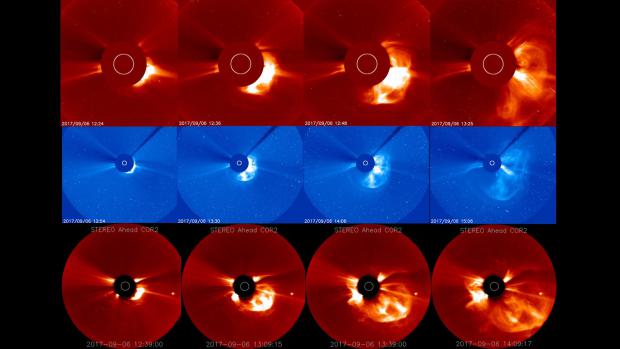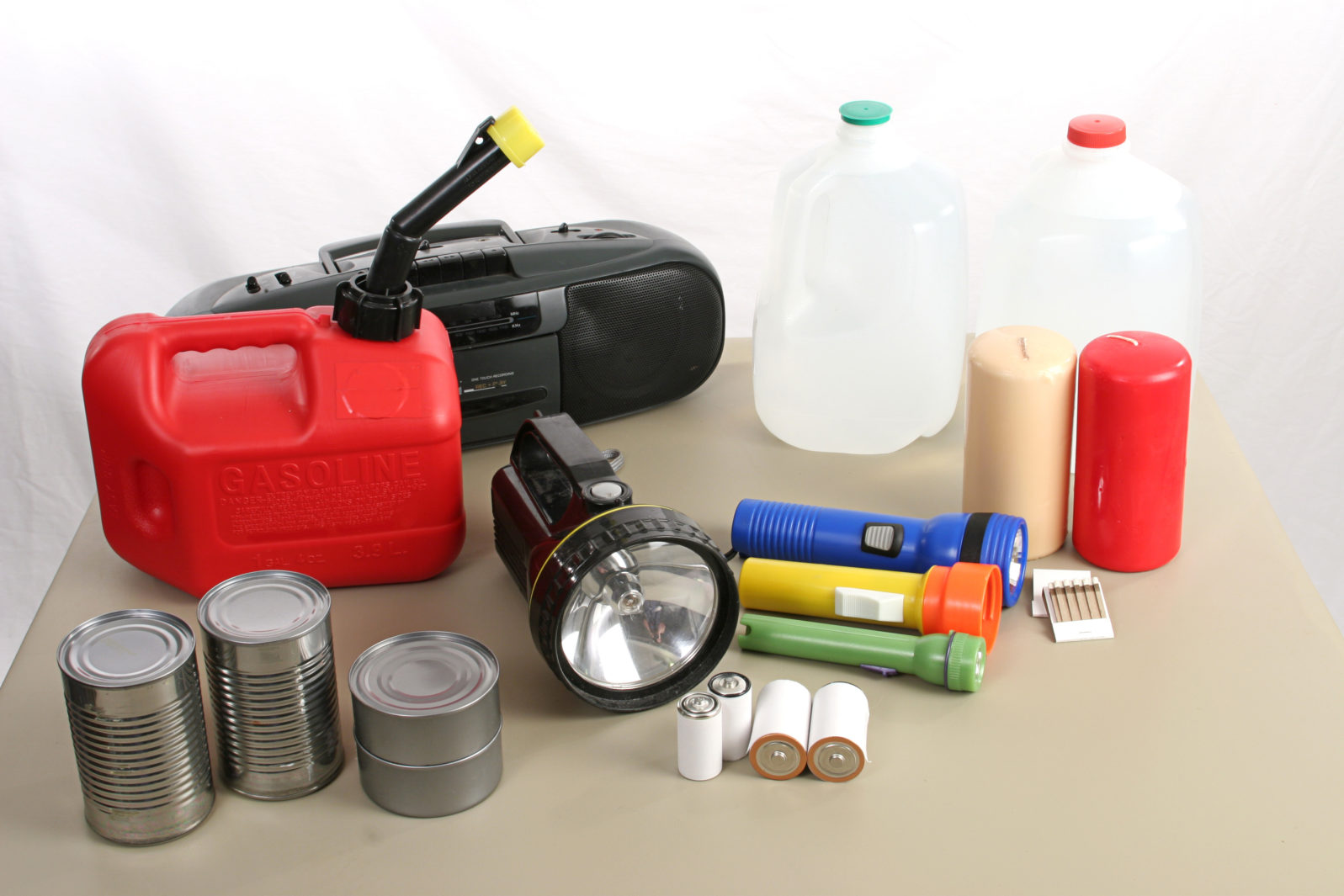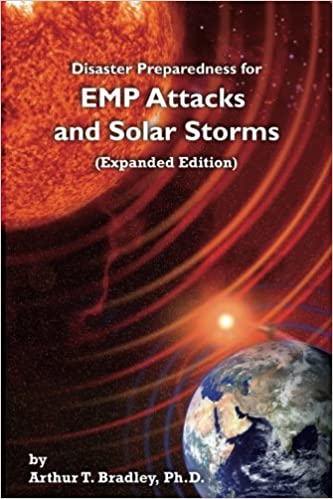What Would It Take To Survive an EMP Attack?
Remember, almost all conventional power sources and the entire internet would be knocked out and might take many months to replaceWe are increasingly vulnerable to both natural disruptions and military attacks on our power grids. Earlier this month I wrote about electromagnetic pulse impulses (EMPs), which would destroy your electronics, leaving you and your surroundings intact — but without easy means of survival.
Force of nature: Sometimes the sun is to blame for knocking out the power supply
Natural disruptions can give us some idea what to expect. When lightning destroys a transformer atop a power pole, nearby businesses and residence must get by without power until the transformer is replaced but it usually doesn’t last long. Far more damage can occur in the rare event that the sun erupts with a major coronal mass ejection (CME) of plasma and magnetic field directed toward Earth.
The first recorded example occurred on September 1, 1859, while British amateur astronomer Richard Carrington was observing the sun. Carrington made careful drawings of the massive solar flare he observed. Less than a day later, a CME arrived and caused spectacular auroral displays. It even affected telegraph equipment, setting some ablaze. Today, such an event can damage or destroy much electrical equipment connected to a network.

NATIONAL OCEANIC AND ATMOSPHERIC ADMINISTRATION
During March 1989, my daughter Vicki detected a string of major solar flares with a Geiger counter she was using for a science fair project. On March 13, one of those flares was associated with a CME that led to powerful electrical transients in transmission lines across Quebec. It tripped circuit breakers and shut down power across the entire province for nine hours. The CME also severely damaged a high-voltage transformer at the Salem New Jersey Nuclear Plant.
Other CME’s have also struck Earth, including a major event in 1921: “Countries such as Australia, Brazil, France, Denmark, Japan, the U.K., New Zealand and the U.S. experienced widespread disruptions in telephone and telegraph communications.” (International Business Times) Here’s how it was experienced at the time:
A telephone station in Sweden burned out, a New York telegraph operator claimed that “he was driven away from his instrument by a flare of flame which enveloped the switchboard and ignited the building”, and telegraph lines in France “seemed possessed by evil spirits”. The event even touched Australia, with the Argus reporting disruptions to telephone services between Melbourne, Sydney and Brisbane.
Delores Knipp & Brett Carter, “The Concerning History of Coronal Mass Ejections” at RealClearScience (October 2, 2016)
In 2012, the sun emitted a CME believed to be more powerful than the Carrington event. Fortunately, it was not pointed at Earth.
The key difference between a natural CME and the dreaded EMP attack
While a massive solar CME could shut down a significant fraction of the world’s electrical grid, electronic devices not connected to the grid would not be damaged. But the electromagnetic pulse emitted by a nuclear explosion is very different because the first of its three phases occurs within billionths of a second. This extremely fast EMP can travel hundreds of miles from an exploding nuke with a voltage potential of 50,000 or more volts per meter. That is far more than enough to permanently damage unshielded semiconductor electronic equipment. The second phase of EMP from a nuke can also damage electronics.
The third phase is much slower and longer. Its target is thousands of miles of high-voltage power lines that serve as EMP antennas. As Russia learned during nuclear experiments in the 1960s, the massive electrical currents absorbed by power lines can critically damage high-voltage transformers and even entire power plants.
A widely speculated scenario is that an enemy might launch an EMP nuke high over the central US in an attempt to shut down the nation’s electrical infrastructure together. Included would be communications networks and the computers and controllers that run everything from traffic lights and emergency vehicles to weather instruments and satellites.
While a nationwide EMP event will not directly injure or kill people, its side effects will. Consider what could happen during critical surgeries or for emergency room patients dependent on working electronic systems, and fast moving vehicles that suddenly lose power while cruising along busy highways.
While this doomsday scenario has been depicted in books and movies, widespread preparation for a nuclear EMP is sorely lacking. Even the US government acknowledges this in various unclassified reports. For example, there’s “Electromagnetic Pulse (EMP): Threat To Critical Infrastructure,” the title of a 2014 hearing before a subcommittee of the Committee on Homeland Security of the House of Representatives. Don’t read any of it before going to bed, for you’ll not be able to sleep. For example,
Another myth is that rogue states or terrorists need a sophisticated intercontinental ballistic missile to make an EMP attack. In fact, any missile, including short-range missiles that can deliver a nuclear warhead to an altitude of 30 kilometers or more, can make a catastrophic EMP attack on the United States, by launching off a ship or freighter. Indeed, Iran has practiced ship-launched EMP attacks using Scud missiles–which are in the possession of scores of nations and even terrorist groups. An EMP attack launched off a ship, since Scuds are common-place and a warhead detonated in outer space would leave no bomb debris for forensic analysis, could enable rogue states or terrorists to destroy U.S. critical infrastructures and kill millions of Americans anonymously.
– From the statement of Peter Pry, Executive Director of the Task Force on National and Homeland Security, May 8, 2014
During the opening of this hearing, Texas representative Michael McCaul began his talk by stating: “We talk a lot about a nuclear bomb in Manhattan, and we talk about a cybersecurity threat, the grid, power grid, in the Northeast, and all these things would actually probably pale in comparison to the devastation that an EMP attack could perpetrate on Americans.”
As I learned after sending an open records request to the city adjacent to my property, most local and national government agencies in the US are unprepared for an EMP attack. Even the US military is not well prepared, for all branches of the military employ off-the-shelf radio gear, computers, mobile phones and other equipment that is highly vulnerable to an EMP event.

Consider what might occur if a relatively small atomic bomb is detonated several hundred miles over Kansas. The EMP from the explosion would cover most of the US within a few billionths of a second. In regions where the EMP created an initial pulse of 30,000 to 50,000 volts per meter, a significant fraction of unprotected electronics would be instantly rendered inoperable. Modern cars and trucks are equipped with EMP-vulnerable microprocessors that control everything from engines to dashboard electronics and entertainment devices. While a vehicle’s metal shielding will provide some protection, it is possible that some vehicles will be rendered inoperable by an EMP. This would not be good for people driving along a packed expressway where only a few inoperable vehicles could cause a massive traffic pileup.
All this assumes a bomb that produces a peak of 50,000 volts/meter EMP, which has long been the standard assumption by the US military. Unfortunately, Russia and China have developed much more powerful super EMP bombs.
Remember that through all this an EMP bomb will not destroy buildings, spread radioactivity, or even make a sound.
What reasonable precautions should we take?
Many personal electronic devices might be rendered inoperable by an EMP, including laptops, radios, and mobile phones. If the initial EMP pulse does not damage the grid, the third phase certainly could. Power plant transformers can cost a million dollars or more and require more than a year to replace, assuming a suitable manufacturer can be found.
While some people can afford to install an expensive EMP-proof solar or propane fueled power supply for their residence, most of us cannot. So what should you try to secure and protect for use after an EMP?
● A compact, battery-powered radio, preferably with shortwave reception, is number one on my list. A second priority is an LED flashlight for every family member. A third priority is a mobile phone loaded with plenty of music and photos of family and important documents. If the cell phone service in your area fails, you’ll be ready when service is restored.
● Other electronic devices you might need include medical devices, a pair of walkie-talkies, and a Geiger counter for use if you are in the fallout pattern downwind from a nuclear attack.
● Be sure to keep spare batteries for most of these devices. Recharging a cell phone is another matter. Unless you possess or have access to a propane or solar generator that can survive an EMP, your best solution is a miniature solar power device. The ones that come with a built-in battery can be charged outdoors and brought indoors to charge your phone. Their main drawback is that rechargeable batteries don’t like heat, and solar-powered battery packs can become very warm.
A small solar panel that charges a phone directly might be a better choice if you keep the phone shaded when it’s being charged. Whichever charging method you select, be sure you have an appropriate cable for connecting it to your phone.
● All these items (except extra batteries) should be stored in EMP-proof containers, sleeves, or bags available online. I describe how to make an EMP-proof sleeve for a laptop or notebook and provide more EMP information in my science column in MAKE magazine: “Amateur Scientist: Solar Flares, EMP, and Faraday Shields.”

For an excellent explanation of EMPs and major solar flares, and how to survive them, you may want to look at Arthur Bradley’s book, Disaster Preparedness for EMP Attacks and Solar Storms (2012). Bradley, an electrical and electronics engineer who has worked at NASA for 18 years, also provides information at his personal site, Disaster Preparer.
● Finally, surviving an EMP event requires more preparation than storing your electronics in EMP-proof bags. Water and food (in that order) will quickly become far more crucial. WaterBOB and similar products will allows safe storage of up to 100 gallons of drinkable water in a bathtub container. That’s enough for at least 50 days for one person and 10 days for a family of five. A water well might provide safe water provided an electricity-driven pump can be powered. Many filter devices are available to cleanse water from rivers and lakes. Some even remove nitrates.
Dr. Bradley discusses water and food storage and personal protection strategies in his book. Other useful sources of information are the Federal Emergency Management Agency guidelines at Nuclear Explosion | Ready.gov. The Red Cross provides additional survival information at Nuclear Explosion and Radiation Emergencies.
With luck, we will never need to think of all this but we ought not to rely on luck alone.
Here’s my article on EMPs as a weapon: Putin vs. Ukraine: New weapons target your electronics, not you Putin’s recent warning about “consequences that you have never experienced” could refer to EMPs that target the computer-based systems that keep us all alive today. Few cities are prepared for electromagnetic pulses that can knock out the grid, clean water, food, sewage, and emergency systems, leaving most folk helpless.
You may also be interested in:
What would a real-world nuclear attack be like? We know some of what it would be like from the records and reconstruction of the atomic bomb attack on Hiroshima. Many nations how have nuclear arsenals that could inflict much greater damage if they were employed during as conflict, perhaps by accident.
and
What would surviving a nuclear explosion be like? Nuclear war has been in the news lately but we naturally try to avoid thinking about its effects. While surviving a nuclear attack might seem impossible, a key lesson from Hiroshima and Nagasaki is that many people will in fact survive. What then?
